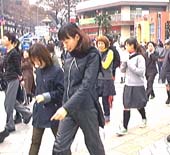|
Top Picks || Arts & Entertainment || Business & Economy || Education & Society ||
NOT DRAB, CLASSIC: Pleats, Gray the Keywords for Winter Fashion December 16, 1998  Tokyo's fashionable neighborhoods are looking gray these days. The hip color for winter 1998-99 is gray. Though gray has often been considered as a color for business suits, it is now filling up Japanese department stores and boutiques, making its way onto women's sweaters, coats, bags, and just about every other fashion item. Meanwhile, pleated skirts are becoming fashionable once again after a hiatus of over a decade. Putting the two together, gray pleated skirts, it seems, are the central component of this season's wardrobe for Japan's trend-conscious women. Gray is the Way Gray, defined in dictionaries as a color that is a blend of black and white, includes a broad range of hues, from the light-toned silver gray that dimly reflects light to the darker charcoal gray. Add a touch of other colors and even more variations can be achieved, such as greenish or brownish gray. The skillful wearer dresses in gray from head to toe, incorporating several different shades in their outfit. Those who are even more adept may play a trick on people's eyes, such as by wearing a black see-through shirt over a white shirt--a combination that appears gray from a distance. Repeating the Pleats Just as with the color gray, pleats come in a wide variety of forms. The two most popular types now are common pleats, folded flat in one direction, and accordion pleats, with the folds alternating inward and outward. Needless to say, the skirts come mainly in gray; also favored are other somewhat neutral hues like khaki and black. In the past, pleated skirts have seen booms in the 1970s and early 1980s. This time around, the trend seems to have been sparked by the spring 1998 Paris collections, unveiled in fall 1997, when Austrian designer Helmut Lang's wide-pleat skirts in delicate fabrics became the center of attention. More designers worked pleats into their fall and winter collections presented in Milan and Paris in spring 1998, and Japanese apparel makers followed suit. As for why pleated skirts caught on in Japan, one stylist says it is probably because they had never been a part of most young women's wardrobes, thus striking this generation as fresh and new. The boom, however, is not limited to young women. It extends to middle-aged women as well, and there are clear generational differences in preference. Teenagers and college students favor knee-length skirts, with wide pleats, in relatively stiff cotton; working women in their 20s and 30s tend to choose longer skirts, anywhere from below the knees to below the ankles, made of thin wool fabric; and homemakers in their 40s and over prefer long skirts with accordion pleats that reach to the ankles.
 Edited by Japan Echo Inc. based on domestic Japanese news sources. Articles presented here are offered for reference purposes and do not necessarily represent the policy or views of the Japanese Government. Edited by Japan Echo Inc. based on domestic Japanese news sources. Articles presented here are offered for reference purposes and do not necessarily represent the policy or views of the Japanese Government.
|
